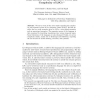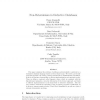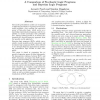105
Voted
DBPL
2005
Springer
15 years 2 months ago
2005
Springer
XQuery is known to be a powerful XML query language with many bells and whistles. For many common queries we do not need all the expressive power of XQuery. We investigate the eff...
118
Voted
BIRTHDAY
2008
Springer
15 years 2 months ago
2008
Springer
Abstract. We survey some of the main results regarding the complexity and expressive power of Live Sequence Charts (LSCs). We first describe the two main semantics given to LSCs: a...
131
click to vote
DOOD
1991
Springer
15 years 4 months ago
1991
Springer
This paper examines the problem of adding non-deterministic constructs to a declarative database language based on Horn Clause Logic. We revise a previously proposed approach, the...
ILP
2000
Springer
15 years 4 months ago
2000
Springer
First-order probabilistic models are recognized as efficient frameworks to represent several realworld problems: they combine the expressive power of first-order logic, which serv...
98
Voted
ICALP
2007
Springer
15 years 4 months ago
2007
Springer
Abstract. This paper studies the expressive power of finite-state automata recognizing sets of real numbers encoded positionally. It is known that the sets that are definable in th...
ESORICS
1994
Springer
15 years 4 months ago
1994
Springer
The Transformation Model TRM was recently introduced 10 in the literature by Sandhu and Ganta. TRM is based on the concept of transformation of rights. The propagation of access ri...
118
Voted
UML
2001
Springer
15 years 5 months ago
2001
Springer
UML is the de-facto standard language for Object-Oriented analysis and design of information systems. Persistent storage and extraction of data in such systems is supported by dat...
BIRTHDAY
2003
Springer
15 years 6 months ago
2003
Springer
We provide a translation from CTL to Datalog¬ Succ. The translation has the following advantages: a) It is natural. b) It provides intuition to the expressive power of CTL and it...
103
Voted
SEMWEB
2004
Springer
15 years 6 months ago
2004
Springer
In 1984, Peter Patel-Schneider published a paper [1] entitled Small can be Beautiful in Knowledge Representation in which he advocated for limiting the expressive power of knowledg...
98
Voted
SEMWEB
2004
Springer
15 years 6 months ago
2004
Springer
Both OWL-DL and function-free Horn rules3 are decidable logics with interesting, yet orthogonal expressive power: from the rules perspective, OWL-DL is restricted to tree-like rule...



